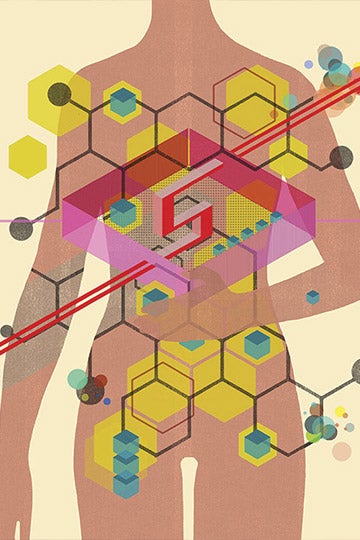
Under the Skin
Engineering an implantable device that delivers insulin to Type 1 diabetics.
By Jade Boyd
The discovery of insulin 100 years ago at the University of Toronto transformed Type 1 diabetes from a merciless executioner into a manageable disease. Insulin shots allow millions of Type 1 diabetics to live normal lives.

But Type 1 diabetics still suffer from long-term effects like kidney disease, high blood pressure, heart disease and stroke. That could change if a pair of Rice bioengineers succeed in creating a living implant that can restore the body’s ability to precisely regulate blood sugar levels.
Research partners Omid Veiseh and Jordan Miller ’08 are creating the implant with engineered cells that can sense blood glucose levels and respond with the correct amount of insulin. The insulin-producing beta cells are made from human stem cells that will be housed in a device made with 3D bioprinting and smart biomaterials.
Veiseh, an assistant professor of bioengineering, has spent more than a decade developing materials that protect implanted cell therapies from the immune system. For more than 15 years, Miller, an associate professor of bioengineering, has researched techniques to 3D-print tissues with vasculature or networks of blood vessels. The three-year research project is supported by a grant from JDRF, the leading global funder of diabetes research.
“If we really want to recapitulate what the pancreas normally does, we need vasculature,” Veiseh said. “And that’s the purpose of this grant with JDRF. The pancreas naturally has all these blood vessels, and cells are organized in particular ways in the pancreas. Jordan and I want to print in the same orientation that exists in nature.” Type 1 diabetes is an autoimmune disease that causes the pancreas to stop producing insulin, the hormone that controls blood sugar levels. About 1.6 million Americans live with Type 1 diabetes, and more than 100 cases are diagnosed each day.
Managing Type 1 diabetes isn’t easy. Insulin intake must be balanced with eating, exercise and other activities, and studies estimate more than two-thirds of Type 1 diabetics in the U.S. have increased long-term health risks because they do not consistently achieve target blood glucose levels.
The duo’s goal is to show that their implants can properly regulate blood glucose levels of diabetic mice for at least six months. To do that, they’ll need to give their engineered beta cells the ability to respond to rapid changes in blood sugar levels.
“We’re using a combination of prevascularization through advanced 3D bioprinting and host-mediated vascular remodeling to give each implant several shots at host integration,” Miller said.
The insulin-producing cells will be protected with a hydrogel formulation developed by Veiseh, who is also a Cancer Prevention and Research Institute of Texas Scholar. The hydrogel material, which has proven effective for encapsulating cell treatments in bead-sized spheres, has pores small enough to keep the cells inside from being attacked by the immune system but large enough to allow passage of nutrients and life-giving insulin.
“Blood vessels can go inside of them,” Veiseh said of the hydrogel compartments. “At the same time, we have our coating, our small molecules that prevent the body from rejecting the gel, so it should harmonize really well with the body.” By incorporating blood vessels in their implant, he and Miller hope to allow their beta-cell tissues to behave in a way that more closely mimics the natural behavior of the pancreas.
